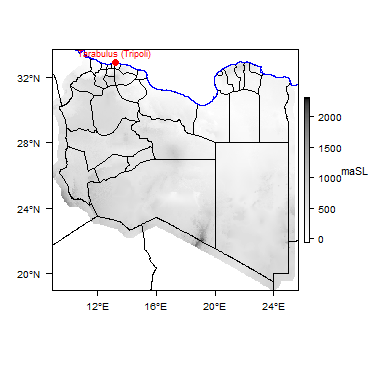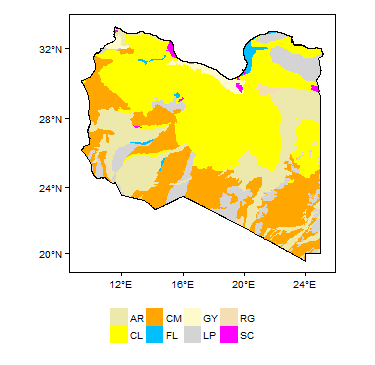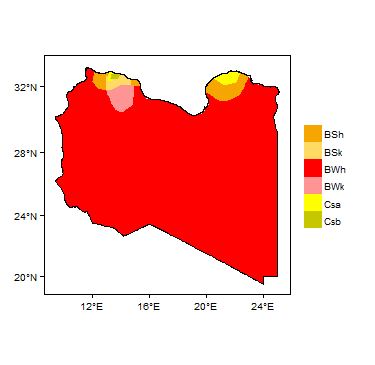Hydrogeology of Libya
Africa Groundwater Atlas >> Hydrogeology by country >> Hydrogeology of Libya
This page has limited information. If you have more information on the hydrogeology of Libya, please get in touch with us.

Libya has been inhabited since ancient times and seen successive occupations, including Romans, Arabs, the Ottoman Empire, Italy and post-second world war Allied forces. Libya became independent in 1951, initially as a kingdom but following a military coup in 1969, ruled by Muammar Gaddafi until he was overthrown in a civil war in 2011. Widespread military, political and civil unrest has continued since 2011. In September 2017 the UN announced a new roadmap for political reconciliation, calling for a constitutional referendum and new general elections within a year.
The Libyan economy depends on oil, which was discovered in 1959. Other natural resources are natural gas and gypsum. There is a very large public sector, and the government is the largest employer in the country. Agriculture, which before oil discovery was the main source of revenue, today accounts for a very small proportion of GDP, and Libya imports large proportions of its food. In the early 1980s, Libya was one of the wealthiest countries in the world, but unrest in recent years, exacerbated by falling global petroleum prices, have had a significant impact on infrastructure and the economy.
Most of Libya is desert, with limited surface water resources, and it relies almost entirely on groundwater, most of which is ‘fossil’ water – recharged thousands of years ago when the region’s climate was wetter. Most agriculture relies on groundwater for irrigation, largely from the Great Man Made River. This was a major project from the 1980s: a network of pipes transporting groundwater abstracted from the Nubian Sandstone Aquifer System, in the Saharan part of southern Libya, northwards to cities and towns on the coast where most of the population lives.
Compilers
Dr Kirsty Upton and Brighid Ó Dochartaigh, British Geological Survey, UK
Dr Imogen Bellwood-Howard, Institute of Development Studies, UK
Please cite this page as: Upton, Ó Dochartaigh and Bellwood-Howard, 2018.
Bibliographic reference: Upton, K., Ó Dochartaigh, B.É. and Bellwood-Howard, I. 2018. Africa Groundwater Atlas: Hydrogeology of Libya. British Geological Survey. Accessed [date you accessed the information]. http://earthwise.bgs.ac.uk/index.php/Hydrogeology_of_Libya
Terms and conditions
The Africa Groundwater Atlas is hosted by the British Geological Survey (BGS) and includes information from third party sources. Your use of information provided by this website is at your own risk. If reproducing diagrams that include third party information, please cite both the Africa Groundwater Atlas and the third party sources. Please see the Terms of use for more information.
Geographical Setting

General
| Capital city | Tripoli |
| Region | Northern Africa |
| Border countries | Egypt, Sudan, Chad, Niger, Algeria, Tunisia |
| Total surface area* | 2,000,000 km2 ( 200,000,000 ha) |
| Total population (2015)* | 6,278,000 |
| Rural population (2015)* | 1,316,000 (21%) |
| Urban population (2015)* | 4,962,000 (79%) |
| UN Human Development Index (HDI) [highest = 1] (2014)* | 0.7245 |
* Source: FAO Aquastat
Climate
More information on average rainfall and temperature for each of the climate zones in Libya can be seen at the Libya climate page.
These maps and graphs were developed from the CRU TS 3.21 dataset produced by the Climatic Research Unit at the University of East Anglia, UK. For more information see the climate resource page.
Surface water
|
There are no permanent rivers in Libya, only ephemeral rivers or wadis. There are several natural desert lakes, which support unique ecosystems and provide a water supply to desert nomads and migrating animals (Abufayed et al. 2015). The main lakes are the Ubari lakes in the Ubari Sand Sea in the south, including the Gaberoun, Mandara and Mafo akes–, the protected Ouau en Namu lakes and the 23rd of July or Benghazi lake, which is more properly a lagoon. The Qattara Depression in the north-west of Libya lies under the sea level and is covered with temporary lakes, salt pans and salt marshes. Other large salt pans include Sabkhat al Hayshah close to the coast near the gulf of Sidra, and Sabkhat Shunayn and Ghuzayyil in the north-east. |
 |
Soil
 |
Land cover
 |
Water statistics
| 2000 | 2001 | 2012 | 2014 | 2015 | |
| Rural population with access to safe drinking water (%) | 68.3 | ||||
| Urban population with access to safe drinking water (%) | 72.1 | ||||
| Population affected by water related disease | No data | No data | No data | No data | No data |
| Total internal renewable water resources (cubic metres/inhabitant/year) | 111.5 | ||||
| Total exploitable water resources (Million cubic metres/year) | 635 | ||||
| Freshwater withdrawal as % of total renewable water resources | 822.9 | ||||
| Total renewable groundwater (Million cubic metres/year) | 600 | ||||
| Exploitable: Regular renewable groundwater (Million cubic metres/year) | 600 | ||||
| Groundwater produced internally (Million cubic metres/year) | 600 | ||||
| Fresh groundwater withdrawal (primary and secondary) (Million cubic metres/year) | 5.55 | ||||
| Groundwater: entering the country (total) (Million cubic metres/year) | 0 | ||||
| Groundwater: leaving the country to other countries (total) (Million cubic metres/year) | 700 | ||||
| Industrial water withdrawal (all water sources) (Million cubic metres/year) | 280 | ||||
| Municipal water withdrawal (all water sources) (Million cubic metres/year) | 700 | ||||
| Agricultural water withdrawal (all water sources) (Million cubic metres/year) | 4,850 | ||||
| Irrigation water withdrawal (all water sources)1 (Million cubic metres/year) | No data | No data | No data | No data | No data |
| Irrigation water requirement (all water sources)1 (Million cubic metres/year) | 1.833 | ||||
| Area of permanent crops (ha) | 300,000 | ||||
| Cultivated land (arable and permanent crops) (ha) | 2,050,000 | ||||
| Total area of country cultivated (%) | 1.165 | ||||
| Area equipped for irrigation by groundwater (ha) | 464,000 | ||||
| Area equipped for irrigation by mixed surface water and groundwater (ha) | No data | No data | No data | No data | No data |
These statistics are sourced from FAO Aquastat. More information on the derivation and interpretation of these statistics can be seen on the FAO Aquastat website.
Further water and related statistics can be accessed at the Aquastat Main Database.
1 More information on irrigation water use and requirement statistics
Geology
The geology map on this page shows a simplified version of the geology at a national scale (see the Geology resource page for more details).
|
|
 |
Hydrogeology
The hydrogeology map below, at 1:5 million scale, shows the type and productivity of the main aquifers at a national scale (see the Hydrogeology map resource page for more details).
More information on the hydrogeology of Libya is available in the report United Nations (1988) (see References section, below).

.
Transboundary aquifers
For further information about transboundary aquifers, please see the Transboundary aquifers resources page.
References
These, and other references with information on the geology and hydrogeology of Libya, may also be available through the Africa Groundwater Literature Archive.
Abdudayem A and Scott AHS. 2014. Water infrastructure in Libya and the water situation in agriculture in the Jefara region of Libya. African Journal of Economic and Sustainable Development, 3 (1).
Abdelrhem IM, Raschid K and Ismail A. 2008. Integrated groundwater management for Great Man-Made River Project in Libya. Eur. J. Sci. Res, 22, 562-569.
Aqeil H, Tindall J and Moran E. 2012. Water security and interconnected challenges in Libya. Tinmore Institute Research Report WS121027.
Abufayed A, Madi L and Radi M. 2015. Libya State of the Water Reporting, Monitoring and Evaluation Operational Framework and Guidelines. Report for CEDARE.
Alfarrah N, Berhane G, Hweesh A and Walraevens K. 2017. Sinkholes Due to Groundwater Withdrawal in Tazerbo Wellfield, SE Libya. Groundwater.
CEDARE. 2014. Nubian Sandstone Aquifer System (NSAS) M&E Rapid Assessment Report. Monitoring & Evaluation for Water In North Africa (MEWINA) Project, Water Resources Management Program, CEDARE.
Dolezal RC. 2016. The Nubian Sandstone Aquifer Dispute. Pangaea Journal.
FAO. 2009. Groundwater Management in Libya Draft Synthesis Report. IAEA. 2013. Four African Nations Agree to Water Management Programme. Press release, 18 September 2013
Fisk EP, Duffy CJ, Clyde CG, Jeppson RW, DeGroot PH, Bhasker Rao, K and Liu, W. 1983. Hydrologic Evaluation of the Coastal Belt Water Project Sarir and Tazerbo Well Fields, Libya. Reports, Paper 487.
Goudarzi GH. 1970. Geology and Mineral Resources of Libya - A Reconnaissance. Geological Survey Professional Paper 660.
Ogilbie, W. 1964. Ground Water in the Sirte Area, Tripolitania, United Kingdom of Libya. Geological Survey Water-Supply Paper 1757-C.
Russeau S. 2011. Libya: water emerges as hidden weapon. Fri 27 May 2011, for IPS.
Stephan RM. 2013. Adoption of Regional Strategic Action Plan on the Nubian Sandstone Aquifer. Post on the International Water Law Project Blog.
UNEP. 2010. Ancient Water is Used to Irrigate a Desert—Murzuq Basin, Libya
United Nations. 1988. Libya: Groundwater in North and West Africa. United Nations Department of Technical Cooperation for Development and Economic Commission for Africa.
van Everdingen, RO. 1962. The deeper ground water in Libya. Hydrological Sciences Journal 7:3, 33-39. doi: 10.1080/02626666209493266.
Wright EP. 1973. Jalu-Tazerbo Project Phase 1. Interim Report. Institute of Geological Sciences Report WD/73/010.
Return to the index pages:
Africa Groundwater Atlas >> Hydrogeology by country







